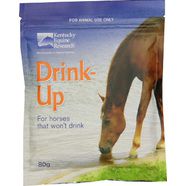How to tell if your horse is Dehydrated
Author: Kentucky Equine Research

DEHYDRATION IN HORSES
When a horse’s body possesses insufficient fluids to function optimally, the condition is described as dehydration.
Fluids are lost through sweating, drooling, respiration, normal excretion of urine and manure. Horses can become dehydrated because of inadequate fluid replacement following losses through sweating, drooling, respiration or strenuous diarrhea. Dehydration in horses is a serious emergency that can lead to kidney failure if not attended to quickly.
Evaluation of dehydration is a subjective exercise. For horse owners, the traditional method of determining hydration status is to perform a skin-pinch test: gently tent a piece of skin on the shoulder between the thumb and forefinger and then release it. If the skin snaps back and unwrinkles quickly upon release, the horse is probably adequately hydrated. If the skin is slow to smooth out and regain its normal appearance, the horse might be dehydrated.

Capillary refill time (CRT) measures circulatory status and is useful in determining dehydration. For horses, CRT is performed on the gums. A thumb or finger is pressed firmly on the gum and then released. The time it takes for the pressed area to return to the same color as the surrounding gum tissue (to perfuse with blood) is the CRT. Most normally hydrated horses have a CRT of less than 2 seconds. As dehydration sets in and worsens, CRT slows.
Assessing the moisture of the gums is another way to determine hydration status. If the gums are tacky with little moisture, dehydration is likely.

Estimation of dehydration in horses:
- 5-7%: Skin tent remains for 2 to 3 seconds; prolonged capillary refill time (CRT), more than 2 seconds; possibly dry mucous membranes
- 8-10%: Skin tent remains for 6 to 10 seconds; prolonged CRT, 2 to 4 seconds; dry mucous membranes; sunken eyes; possible signs of shock (irregular heartbeat, weak pulse, poor jugular filling)
- >10%: Skin tent remains when pulled; CRT greater than 5 seconds; cold extremities
- 12-15%: Shock; death
Low-grade dehydration can be self-corrected to adequate access to water. If dehydration is mild to moderate and there is no gastrointestinal obstruction or reflux, fluid replacement is often best achieved by offering water and electrolytes free choice. Alternatively, a veterinarian may administer these through a nasogastric tube to ensure delivery.
Severe dehydration, however, is most frequently associated with ill horses or those engaged in high-performance activities, and this condition requires immediate veterinary intervention. Intravenous fluid replacement is often the treatment of choice for severely dehydrated horses.
If you worry about your horse getting dehydrated as many horses do that refuse to drink when travelling or at competions, check out the range of electrolyte products at The Vet Shed.

Pet Goodies from the Land down Under: Australian Pet brands
Everyone loves a homegrown talent; this is true for Australia as well. The Vet Shed, an Australian based online pet shop recognizes the quality and goodness that homegrown companies put into their products that is why they are supporting items produced by Australian brands. Let us look at the Top 3 Australian pet brands that a...









